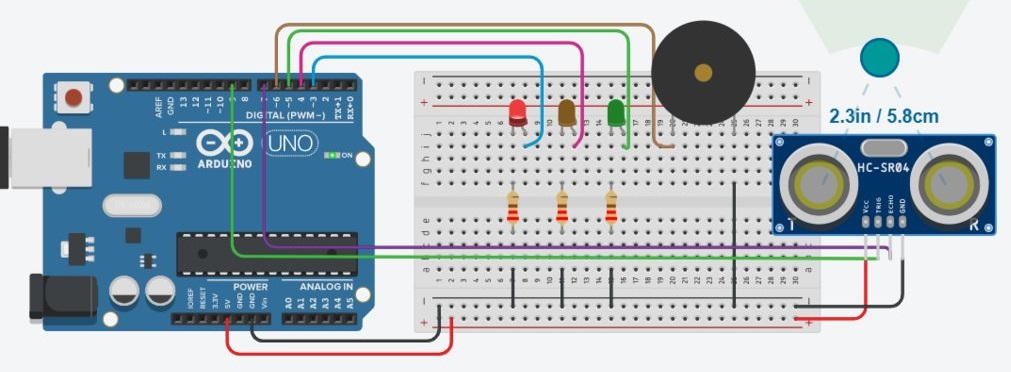Car Parking Sensor At Home

In this project, I will design a simple Arduino Car Reverse Parking Sensor Circuit using Arduino UNO and HC-SR04 Ultrasonic Sensor. This Arduino based Car Reverse Sensor can be used for an Autonomous Navigation, Robot Ranging and other range related applications.Almost all modern cars are equipped with reverse parking sensors that are activated when the car is put in reverse gear and beep at variable rate depending on the distance between the car and the closest obstacle.The Reverse Parking Sensors that are equipped in the car are basically Ultrasonic Proximity Sensors i.e. they use Ultrasonic Sensors to measure the distance between the car and the object and warn the driver if the car is too close.In this project, we built a simple prototype of a Car Reverse Parking Sensor with the help of Arduino UNO and the very famous HC-SR04 Ultrasonic Sensor.
Components
Arduino Uno
Ultrasonic Sensor
Breadboard
Led
Buzzer
Resistor 220 Ohm
| Components | Hexkart | Flipkart |
|---|---|---|
| Arduino | Buy Now | Buy Now |
| Ultrasonic Sensor | Buy Now | Buy Now |
| Breadboard | Buy Now | Buy Now |
| Buzzer | Buy Now | Buy Now |

Arduino
Arduino is an open source electronic prototyping platform.Arduino board designs use a variety of microprocessors and controllers. The boards are equipped with sets of digital and analog input/output (I/O) pins that may be interfaced to various expansion boards ('shields') or breadboards (for prototyping) and other circuits. The boards feature serial communications interfaces, including Universal Serial Bus (USB) on some models, which are also used for loading programs. The microcontrollers can be programmed using the C and C++ programming languages, using a standard API which is also known as the Arduino language, inspired by the Processing language and used with a modified version of the Processing IDE.
Ultrasonic Sensor
An ultrasonic sensor is an electronic device that measures the distance of a target object by emitting ultrasonic sound waves, and converts the reflected sound into an electrical signal. Ultrasonic waves travel faster than the speed of audible sound (i.e. the sound that humans can hear). Ultrasonic sensors have two main components: the transmitter (which emits the sound using piezoelectric crystals) and the receiver (which encounters the sound after it has travelled to and from the target).Ultrasonic sensors are used primarily as proximity sensors. They can be found in automobile self-parking technology and anti-collision safety systems. Ultrasonic sensors are also used in robotic obstacle detection systems, as well as manufacturing technology. In comparison to infrared (IR) sensors in proximity sensing applications, ultrasonic sensors are not as susceptible to interference of smoke, gas, and other airborne particles (though the physical components are still affected by variables such as heat).Ultrasonic sensors are also used as level sensors to detect, monitor, and regulate liquid levels in closed containers (such as vats in chemical factories). Most notably, ultrasonic technology has enabled the medical industry to produce images of internal organs, identify tumors, and ensure the health of babies in the womb.
Circuit Diagram

Arduino Code
int l1 = 5; // green led
int l2 = 4; // orange led
int l3 = 3; // red led
int buzzer = 6; // buzzer
int trig = 9;
int echo = 7;
void setup()
{
Serial.begin(9600);
pinMode(l1, OUTPUT);
pinMode(l2, OUTPUT);
pinMode(l3, OUTPUT);
pinMode(buzzer, OUTPUT);
pinMode(trig, OUTPUT);
pinMode(echo, INPUT);
}
void loop()
{
digitalWrite(trig, LOW);
delayMicroseconds(5);
digitalWrite(trig, HIGH);
delayMicroseconds(10);
digitalWrite(trig, LOW);
int a = pulseIn(echo, HIGH);
int distance = a * 0.0343 / 2;
Serial.print("Value of US sensor");
Serial.println(distance);
if (distance < 50)
{
digitalWrite(l1, HIGH);
digitalWrite(l2, LOW);
digitalWrite(l3, LOW);
digitalWrite(buzzer, LOW);
}
if (distance < 30)
{
digitalWrite(l2, HIGH);
digitalWrite(l1, LOW);
}
if (distance < 10)
{
digitalWrite(l2, LOW);
digitalWrite(l1, LOW);
digitalWrite(l3, HIGH);
digitalWrite(buzzer, HIGH);
delay(150);
digitalWrite(buzzer, LOW);
delay(150);
digitalWrite(buzzer, HIGH);
delay(150);
digitalWrite(buzzer, LOW);
delay(150);
}
Hours
Monday - Saturday: 9:00 AM - 5:00 PM
Sunday: Not Working
Location
PJ5190, South Road, Mudavanmugal, Poojappura,
Trivandrum, Kerala 695012
Book Now
+91 9633118080

